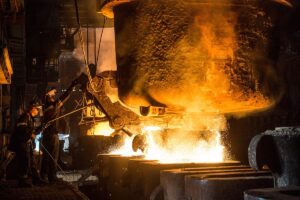 In an interview on NPR, Eliese Goldbach, the author of Rust, talked about working in a steel mill during the recession of 2008. When asked how her ideas about steelworkers changed during her three years there, she explained that they weren’t just one type of person. Some were liberal and some conservative. Some had degrees, some didn’t. They came from different backgrounds. Like her, many were there because they could make more money than in other jobs. And, as with many jobs, steel making became a big part of their identity and the mill workers became like a family. In short, she learned that being an industrial worker isn’t just one thing and that many of them were just like her.
In an interview on NPR, Eliese Goldbach, the author of Rust, talked about working in a steel mill during the recession of 2008. When asked how her ideas about steelworkers changed during her three years there, she explained that they weren’t just one type of person. Some were liberal and some conservative. Some had degrees, some didn’t. They came from different backgrounds. Like her, many were there because they could make more money than in other jobs. And, as with many jobs, steel making became a big part of their identity and the mill workers became like a family. In short, she learned that being an industrial worker isn’t just one thing and that many of them were just like her.
You’ve heard this lesson before.
From travelers who discover people in other countries are varied but also so much like ourselves.
From movies that take us back in time to entirely different worlds where the challenges are unimaginable, but the people are compelling simply because they are a lot like us. Because they care about the same things we do: family, health, safety, falling in love.
From books, sermons, and documentaries, the lesson is the same. Every one of us is unique, but we all have so much in common.
So why is it we still stuff people we’ve never met into boxes with labels that clearly mark them as different from ourselves? And, to make matters worse, we then allow assumptions and stereotypes affect the way we treat them? Liberals and conservatives. Trumpers and never-Trumpers. Gay and straight. Rich and poor. White-collar and blue-collar. How many times do we have to learn this lesson that we are all different and also much alike?


Comments are closed.